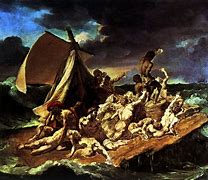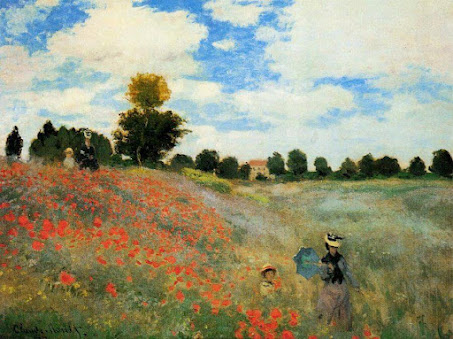I would like to share what I have learned about what I feel to be the two main art styles of the Romantic Era: Romanticism and Realism.
The Raft of Medusa
Theodore Gericault (1819)
Depicted above are two Romantic paintings. The first is The Raft of the Medusa by Theodore Gericault. This was painted in 1819 in France three years after a devastating naval disaster that serves as the subject of the painting. This painting demonstrates several key Romantic motifs in its image, one being its grim portrayal of tragedy, not putting on airs to cover up a dark moment in history. Its subjectivity is also a commonly seen trait in Romantic paintings, with the only thing objectively being shown being human suffering, leaving the viewer to create their own narrative, who was to blame for this?
The use of tone is extremely dramatic, holding onto techniques of the neoclassical era while advancing the message of the painting in a manner nearly antithetical to that of Neoclassicism. While I greatly appreciate this painting's scene and techniques, I also find it absolutely gruesome and would not wish to display this anywhere someone wishes to sleep.
Newton
William Blake (1795)
Another Romantic piece I wish to go over is that which is depicted above: Newton by William Blake. This was painted around 1795 in London and shows Isaac Newton ignoring natural beauty to instead ponder a compass. This is indicative of a problem Blake had with Newton's rationale and a deeper difference between Romanticism and styles before it. In this painting Blake makes beauteous use of shape to demonstrate the mystical next to the cold, harsh geometry of Newton's reason. So, too, Romanticism sought to instill a sense of wonder and mystery in a world becoming more reasonable and explained by the day. I enjoy this painting far more than the one above, and personally wouldn't mind having it around for its soft colors and pleasing use of shape.
Realism emerged in response to Romanticism during this period and sought to display the true state of man at the time, neglecting the complicated subjectivity of the Romantics.
The Stonebreakers
Gustave Courbet (1849)
Courbet painted the above work in 1849 in France. This work exemplifies many common trends and subjects in Realist painting. The image shows two stone breakers working a hard job, without a hint of glamour or glory to the work. In a time of industrialization and an expansion of the labor force, scenes like these would become the days of many. This focus on the common individual and the struggles they faced became the primary trend in Realist art. Courbet makes great use of texture and tone in this painting to give a gritty and dirty feel to the image, making the work the two subjects immerse themselves in seem all the more painful and real.
The Gross Clinic
Thomas Eakins (1875)
This painting was made by Thomas Eakins in 1875. The work depicts Doctor Samuel Gross performing surgery, a field of medicine that greatly expanded during this time. The painting is doused in grey, showing this breakthrough moment not in glorious or dramatic light, but drab colors that muddle the image and make it grounded. Like the above painting it does not glorify any of what is done, nor does it leave any mystical themes to interpretation, it only strives to depict the world as it is for any person.
I actually quite enjoy this painting even thought it was seen as rather ghastly at the time and would far prefer to own a print of it over the other realist work.
While Romanticism and Realism had their differences in what they chose to portray, they were undeniably shaped by the styles that came before them and both have great works to their name. Although I prefer the mysterious tone of Romantic paintings, I also have a great love for Realist paintings and their unabashed portrayals of life as the artist saw it.
Bibliography
“Courbet, the Stonebreakers (Article) | Khan Academy.” Khan Academy, 2019, www.khanacademy.org/humanities/ap-art-history/later-europe-and-americas/modernity-ap/a/courbet-the-stonebreakers.
““The Gross Clinic” by Thomas Eakins | Columbia Surgery.” Columbiasurgery.org, columbiasurgery.org/news/2016/01/14/gross-clinic-thomas-eakins.
Britannica. “The Raft of the Medusa | Painting by Géricault.” Encyclopædia Britannica, 2019, www.britannica.com/topic/The-Raft-of-the-Medusa.
““Newton”, William Blake, 1795-c.1805 Tate, 2018, www.tate.org.uk/art/artworks/blake-newton-n05058.






Entering a test comment
ReplyDeleteTest comment - again
ReplyDeleteOzzy, I really enjoyed reading about all of the paintings you chose to showcase to compare Romanticism and Realism. Your descriptions of the paintings were informative and easy to grasp. I've never seen Newton by William Blake before and I'd have to say it was my favorite out of the four. Not only is it done in the Romantic style which I prefer over Realism, but it's such an interesting concept and truly beautiful. I can see Blake's idea of turning away from idealized beauty towards another form of beauty. The main emotion I get from the piece is inspiration. I'd also have to agree that I'd much rather prefer Newton over The Raft of Medusa to be hung in my house (lol). Overall, great post!
ReplyDelete